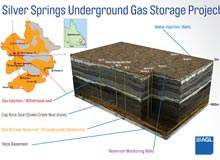
AGL Energy inaugurated its new Silver Springs underground gas storage facility in November 2011. It is located in the Surat-Bowen Basin in Queensland, Australia. The facility is the biggest such project to have been undertaken in Queensland.
The decommissioned Silver Springs / Renlim gas field reservoir was converted into the current storage facility. Silver Springs has a storage capacity of 44 billion standard cubic feet (bscf) of gas and is operated by AGL Gas Storage.
The project was originally planned for development by Mosaic Oil, which was acquired by AGL in October 2010. The acquisition included the Silver Springs / Renlim gas fields.
Reservoir characteristics the reason for the Queensland site choice
The Silver Springs / Renlim gas field was considered as the ideal location for development of the facility due to the characteristics of the reservoir. Silver Springs gas field was discovered in 1970 and the Renlim gas field in 1982.
The fields produced gas between 1978 and 1999. More than 90bscf gas and 0.4 million barrels (MMbbls) of condensate was recovered during this time. Gas production ceased in 2000 and the field reservoir is now nearly depleted.
During the production phase, the reservoir had a pressure of 2,790psi. It is located at a depth of 1,900m and is made of highly porous Showgrounds formation sandstone. The Showgrounds formation has a high porosity of 12% and good permeability, making it suitable for gas storage.
Gas is stored in the space between the sandstone grains of the reservoir. The reservoir is sealed by an impermeable layer of shale and enclosed by gas-water contacts.
Construction, infrastructure and gas supply of the Silver Springs / Renlim field
The Silver Springs facility includes a purpose-built compressor, a pipeline connecting the compressor to the existing Silver Springs pipeline and wellhead equipment. The compressor unit includes control devices, inlet filters, safety systems and catalytic converters.
A pipeline connects the compressor with injection wells. Three existing wells were modified to enable gas injection and withdrawal. In addition, a new well, Silver Springs 12, was drilled for the project. All wells have been isolated with cement and steel casing to prevent any contact with aquifers and water bores located in the area.
To enable withdrawal of gas, new process equipment including a three phase separator, Triethylene Glycol (TEG) dehydrator and a gas heater have been added to the facility. Silver Springs will store gas for QGC, a unit of the British Gas (BG) Group. It will enable gas to be stored for years until QGC completes the development of the Queensland Curtis liquefied natural gas (LNG) project in 2018.
The Queensland project will convert coal seam into LNG for export. Once the Queensland project becomes operational, gas will be withdrawn and transported to the Gladstone LNG facility for LNG production and export.
AGL will provide QGC with storage services until 2018. After this period, AGL will be able to use the facility, providing significant commercial opportunities.
The facility will enable AGL to manage seasonal variations in gas demand during the summer and winter months. AGL also plans to provide seasonal and long-term storage services. The facility is located near the Wallumbilla gas hub in Queensland, enabling easy delivery of gas to the Brisbane, Gladstone and Mount Isa markets.
Pipeline and storage processes for the Silver Springs / Renlim gas field
QGC supplies gas to the facility through a new connection built between the Berwyndale to Wallumbilla pipeline owned by the APA Group and the Silver Springs pipeline. Gas is transported from the Wallumbilla gas hub to the facility through an existing pipeline.
To store gas in the facility, gas needs to be at a higher pressure than the reservoir. To achieve this, gas is passed through the compressor and then to the wellheads, from where it is injected into the reservoir. The water quality, reservoir pressure and gas-water contact is closely monitored.
Contractors involved with AGL Energy’s underground gas storage facility
WDS was awarded the engineering, procurement, fabrication and construction contract for the facility in March 2011.

